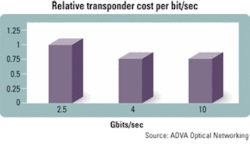Metro WDM networks turn to 4G
For the growing interest in 4-Gbit/sec networking, it’s a matter of math and maturity.
First, the math: 4-Gbit/sec optical-networking components such as pluggable transceivers deliver 60% more bandwidth than 2.5-Gbit/sec models at a cost increase that vendors expect will be in the 10%-20% range. That is a compelling bargain.
Second, the maturity: While 4G networking is a new trend in the metro WDM arena, it’s not a new technology. Rather, it’s proven technology being perfected. Enhanced processes in manufacturing 2.5-Gbit/sec transponders, for example, are simply yielding higher-performance devices capable of supporting 4-Gbit/sec transmission.The net result is a new degree of cost-effective flexibility for enterprises supporting high-bandwidth applications among MAN locations or for carriers offering managed services to business customers. SAN applications and managed storage services-specifically those using Fibre Channel-are spurring the emergence of 4-Gbit/sec transponders and associated components. These new devices in turn have created new options for enterprise-network managers and carrier service planners.
Few topics in networking in the last five years have garnered as much interest as storage. Enterprise decision-makers have amassed a keener understanding of the varied exponential costs of application downtime-network unavailability means revenue loss, staff idleness, and reputation damage-and they sought protection via more sophisticated storage networking. At the same time, governments around the globe began legislating data security.
Historically, storage networking had been a “make” scenario, in which large enterprises built and supported their own SANs. With a wider variety of companies becoming interested in adopting powerful business continuity and disaster recovery capabilities, carriers began rolling out managed storage services. “Buy” became a legitimate alternative for enterprises determined to improve storage capabilities while resisting new IT burdens and costs.
Not only did these leading edge SAN applications and storage services deliver unprecedented levels of protection, they also created compelling new operational possibilities. Able to extend in-building network performance across a metro area, an enterprise (or enterprise customer) could more strategically and cost-effectively distribute personnel and information resources. A brokerage firm, for instance, could keep its traders’ offices in a high-rent downtown financial district and move its support staff to less expensive real estate in suburban locations.
The WDM-enhanced optical network emerged as the underlying foundation of these SAN-in-the-MAN capabilities. In WDM, individual applications are assigned wavelengths, multiplexed at one end of an optical link, and demultiplexed at the other end. Since protocol conversion is unnecessary, there are no limitations regarding bit rates and protocols as well as minimum latency. These features are critical for storage networking, since the most popular storage protocols-Fibre Channel, Escon, Ficon, coupling link, sysplex timer, and InfiniBand, among them-are sensitive to latency and require a wide range of speeds from 8 Mbits/sec all the way to 10 Gbits/sec.
Given intense interest among enterprises and carriers, SAN applications and storage services have steadily grown to account for a more significant ratio of overall bandwidth usage in the MAN. Connections among SANs have typically run at 1 or 2 Gbits/sec, but these speeds are proving insufficient for newer bandwidth-intensive applications like graphics and video.
Instead of simply procuring more servers and storage arrays and deploying more equipment racks and optical channels, enterprises and carriers have sought higher-power storage networks. Some are making the leap to 10-Gbit/sec systems. For many organizations, however, that leap is simply too far. There are a variety of reasons:
• Security is better served by not concentrating all of an enterprise’s storage traffic on a given pipeline. It is more prudent, for example, to split 8 Gbits/sec’s worth of highly sensitive storage traffic over two 4-Gbit/sec links than it is to carry the full load on a single wavelength.
• 10-Gbit/sec systems are considerably more expensive than traditional 1- and 2-Gbit/sec systems-a significant deterrent for enterprises and carriers that do not yet require the five times greater capacity delivered by 10-Gbit/sec approaches. In addition, today’s pluggable 10-Gbit/sec-transceiver technologies are not as compact and power-efficient as the lower-speed small-form-factor-pluggable (SFP) devices conventionally deployed today.
• In some cases, dispersion issues, length of fiber strand, age of fiber, and other logistical challenges have prevented deployed optical networks from supporting speeds as high as 10 Gbits/sec.
Into this gap has stepped 4-Gbit/sec optical networking. Manufacturers of transponders, host adapters, loop switches, drive decoders, disk drives, disk array controllers, etc., are answering a call from enterprises and carriers alike for a new degree of granularity in securely and cost-effectively “rightsizing” pipes in metro WDM storage networks.
The trend toward 4-Gbit/sec optical networking is also evident in activity among standards bodies; 4G Fibre Channel, for example, was ratified last year.
The rise of 4-Gbit/sec networking has been an organic evolution. Producing 4G systems has not required significant new research and development among optical-networking vendors. The new systems are natural outgrowths of refining processes in manufacturing devices for existing storage and optical transport systems, and that has helped ensure backward-compatibility with existing equipment and traffic protocols.
And while it is too early in the technology’s commercial availability to pinpoint pricing, pre-volume indications suggest that 4G capabilities will generally cost only 10%-20% more than 2.5G systems. That actually translates into a savings in favor of 4 Gbits/sec (see Figure on front page).
Looking at the math, 16 2.5G-transponder pairs are necessary to carry 40 Gbits/sec of traffic, while only 10 pairs operating at 4 Gbits/sec would be required. If each 4G device costs 20% more than a single 2.5G model, the total outlay to support the 40 Gbits/sec of data is 25% less for 10 of the 4G-transponder pairs than it would be for 16 2.5G models.
Greater flexibility in cost-effectively scaling networks, proven systems, affordability-it’s easy to understand the trend toward 4 Gbits/sec in metro WDM networking.Per Hansen is the director of business development for ADVA Optical Networking (Mahwah, NJ, www.advaoptical.com).

